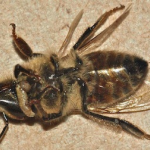- Here in Socal, I find bees on the ground either acting drunk or dead. Could fit the pattern
Maybe scoop them up and put them in a sealed container, just to see if larvae emerge? The grub is emerging from the neck area

Posted on 01/05/2012 10:00:37 AM PST by BlueDragon
A heap of dead bees was supposed to become food for a newly captured praying mantis. Instead, the pile ended up revealing a previously unrecognized suspect in colony collapse disorder—a mysterious condition that for several years has been causing declines in U.S. honeybee populations, which are needed to pollinate many important crops. This new potential culprit is a bizarre—and potentially devastating—parasitic fly that has been taking over the bodies of honeybees (Apis mellifera) in Northern California.
(Excerpt) Read more at blogs.scientificamerican.com ...
Bush’s fault.
That’s okay, there’s a chinese needle snake we can bring in to go after the flies.
“But then we’ll be overrun with chinese needle snakes!”
Then we bring in these gorillas that love snake meat.
“And what about the gorillas?”
That’s the beauty of it, when winter comes, the gorillas just freeze to death.
/simpsons
I had heard it was cell phone towers. :)
I think I remember running across the same thing, possibly mention of it here.
Check out this comment at Bee-L
Although not bee specific, it mentions another instance of parasites seeming to hijack the nervous system/ behavior of an host insect, causing a suicide type of affair, which benefited the parasite.
You know, sort-of like Obama and his cronies taking over the U.S. and making zombie followers out large portions of the electorate.
One woman mentioned in the article which you provided a link for, Marla Spivak, was the breeder behind what is called "Minnesota Hygienic".
The other bee breeder mentioned (other than the couple featured) is Sue Coby whom in conjunction with another(?) breed the NWC (New World Carniolan). She also has been able to bring some genetics in from Europe to bolster that line. All of which can help. Many breeders can provide NWC queens.
Coby has been holding an artificial insemination teaching program at UC Davis for the past. I think she still does, and is one of the best, possibly the best instructor.
Since the article mentioned them, I cannot but help but think that this couple who was successful in Maryland were utilizing something from these two women, but then again there is much overlap in bee genetics, too.
Google "Brother Adam" of "Buckfast" bees, (Buckfast Abbey) for info on a monk in England who bred super bees, blending bees from all over Europe, and even Africa (apis mellifera monticola), a high elevation African bee with many positive traits, not to be confused with the swarmy, defensive, low elevation hot weather scutelatta bee that was bred with European bees in South America, giving us the Africanized (AHB)or killer bee. The monticola can be found in a present European breeding line, under the name Mt. Elgon, I think. Not importable to the U.S., but not because of a bit of African strain, but more due to the present tight restriction on imports of any bee genetic material, though we can still receive bees from Canada, for a certainty.
There might even be a bit of Buckfast in Minneapolis Hygienic? I really don't know, just wild speculation, since it wasn't exactly a "line" as it would change over the years, but some of those bees were brought in to the U.S., mixing with the genetics we have here already.
Russian bees have been a part of some breeders hygienic breeding attempts. They have been exposed to the mite for longer, and naturally otherwise produce more propolis, which is bad for sticking hive parts together, but good for sanitation and cold surviving cold weather. One drawback with the Russian bees is they are slow to build up. No so with the Minnesota, I hear. Many have praised them highly. They take off (rebuilding population in early spring) as well or better than most italians, or carniolans. I think Spivak offers a few different flavors or crosses of her hygienic line. It's been a while since I looked.
Like a lot of people in the (sort-of) know, I wonder if there were any old line carniolan feral survivors on Santa Cruz Island which the bee biologist Adrian Wenner from UCSB deliberately introduced the varroa mite to, in an effort to destroy them, after years of bee-lining and trapping couldn't eradicate them from the Island. That was done as part of the effort to restore the Island back towards natural flora and fauna. Personally, I think the bee strains, and the fact they were isolated was far more valuable than a greeny Park Service dream of putting nature back to pre-european settlers condition.
Just think. Not only were those bees varroa free, they may also have been isolated from many viruses, and the microspordian Nosema, which in conjunction with IIV (invertebrate iridescent virus) and a couple of paralysis and wing deformation virus, have been previously found to have been all present in other earlier CCD diagnosed colonies.
I am just learning about mason bees (Osmia lignaria) now from seeing them in garden catalogs. Quite a neat little species: much more effective pollinizers than honeybees and very docile.
http://gardening.wsu.edu/library/inse006/inse006.htm
Since they are solitary, I’m guessing they don’t suffer from colony collapse or anything like that.
Here in Socal, I find bees on the ground either acting drunk or dead. Could fit the pattern.
The folks in CA this concerns the most are the almond growers, but then they have been dealing with the increases in pollination contract costs for a some years now. We pay for it in higher costs in the market.
There are so many overlaps concerning this latest discovery of the parasitic fly which had previously not been seen to attack honey bees. For a while now, it has been noted or speculated upon that virus transfers between bumbles and EHB had been occurring, and that bumbles had been suffering from --- what I don't know exactly. The virus transfer was thought to occur while both were visiting flowers. That may be the case, but this parasitic fly is another strong candidate as being a vector for virus not looked upon much previously. Both transfer methods may have been occurring. It's going to take a while to sort this out. All I can do is watch, and try to connect the dots without going too far off the with speculation, like blaming it all on cell phone towers. The varroa mites had also been seen as a vector among honeybees themselves, and also as weakening agent, in that the mite feeds on the bees blood, weakening the bees enough to succumb to virus,,and nosema infection.
Maybe scoop them up and put them in a sealed container, just to see if larvae emerge? The grub is emerging from the neck area

I don't know if they have been suffering like the bumbles have been reported to have been recently.

——the carefully bred queen bee——
While I believe there is the potential for breeding, I doubt the ability to genetically transfer immunity to a different species.
I have the greatest respect for bee capabilities and do believe it is possible for them to develop strategies for killing the colony collapse cause. It is not however genetic.
Having watched bees for years and years, and having watched Cowboys and Aliens last night, I am still convinced that we will never be able to communicate with aliens if we can’t talk to our honey bees.
Snow Bee’s.

I'm dealing with some dumb English Wasps that took up residence at my yard last year. They're 'scary big,' but quite dumb, even when I spray them directly.
I'm waiting for spring to see how many are left.
Here's someone talking about different races,and cross strains. The page is years old, I don't know how much of the info is valid anymore. http://beetalk.tripod.com/bees.htm
Disclaimer: Opinions posted on Free Republic are those of the individual posters and do not necessarily represent the opinion of Free Republic or its management. All materials posted herein are protected by copyright law and the exemption for fair use of copyrighted works.